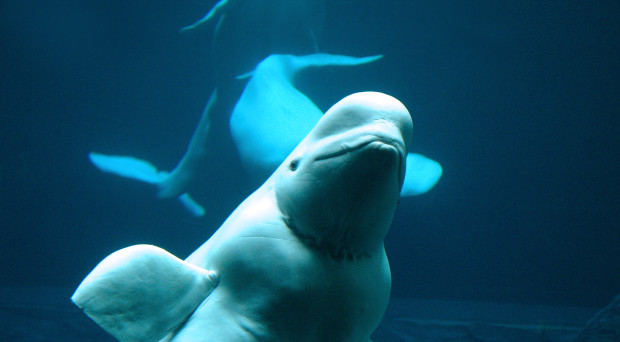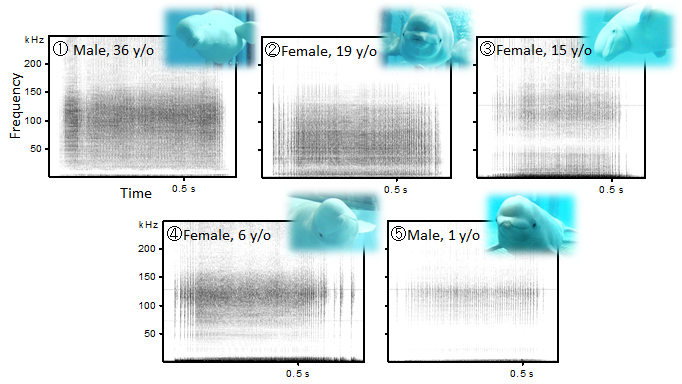
Animals with complicated fluid social systems exchange individualized contact calls to maintain relationships. Studies on bottlenose dolphins over the past 50-years have revealed that their contact calls, also known as ‘signature whistles’, were similar to the form of ‘names’ in humans.
Bottlenose dolphins have individually distinctive frequency modulation patterns in signature whistles. The identity information was independent of voice cues, and the individual pattern was obtained by vocal learning. Further, dolphins copy the signature whistles of group members and use them to label specific group members.
This type of contact call was found in only bottlenose dolphins and a parrot species other than humans. Why have these species obtained names? How has the individual recognition system evolved? We were interested to find out whether this type of contact call is unique to these species, and specifically whether other toothed whales produce this type of contact calls.
More about beluga whales
They may integrate these skills into an individual recognition system of contact calls akin to that in bottlenose dolphins.
Beluga whales are a circumpolar and annual-migratory species. They have similar fluid social structure to bottlenose dolphins. Thus we expect that they use individually distinctive contact calls. Further, they mimic human speech and synthetic sounds, and can label objects using sounds. Thus, they may integrate these skills into an individual recognition system of contact calls akin to that in bottlenose dolphins.
Belugas are called ‘sea canaries’ and they produce various calls. Although little was known about contact calls in belugas, some past studies reported that they used pulsed sounds which were the other type of two widely categorized call types in toothed whales, rather than whistles for mother-calf contact calls.
Previously, Dr. Morisaka and his colleagues suggested individuality in contact calls of belugas. They reported that belugas frequently exchanged one type of individualized pulsed sound, called ‘PS1’. However, only a small amount of data was analyzed in a short period.
Therefore we conducted a subsequent investigation of PS1 to evaluate its function as a contact call and individuality. This is the first step in assessing whether PS1 calls have a parallel function to signature whistles in bottlenose dolphins.
What did we do?
Recordings were conducted on each of five belugas at the Port of Nagoya Public Aquarium in Japan, including both sexes and various ages. We separated each animal into a sub-pool and made an isolated context to elicit contact calls from them.
As a result, PS1 was the most common call type in isolation which suggested that PS1 functions as a contact call. Further one sub-adult and three adults had individually distinctive and stereotyped pulse repetition pattern in PS1; one calf showed no clear stereotyped repetition pattern.

The above image shows PS1 samples from five belugas. You can hear PS1 calls from no. 1 to no. 5. here. PS1 is not a beautiful sound in contrast to whistles and it sounds like a door creaking to human ears, although we can hear a part of PS1 because it contains the ultrasonic component (>20 kHz).
The difference of pulse repetition pattern among samples may be unclear for humans, but it may be perceived clearly by belugas because their auditory system had higher temporal resolution than that of humans.
What did we find?
The findings mean that belugas use PS1 as an individualized contact call. If belugas encode signature information in PS1 calls, as seen in bottlenose dolphins, the pulse repetition pattern may be the carrier, as it is individually stereotyped and appears to require vocal development.
The next step is playback experiments to elucidate whether the individual differences were perceived by belugas, and whether the pulse repetition pattern functions as a signature.
- Do beluga whales give themselves names? - 7th October 2015
Comments